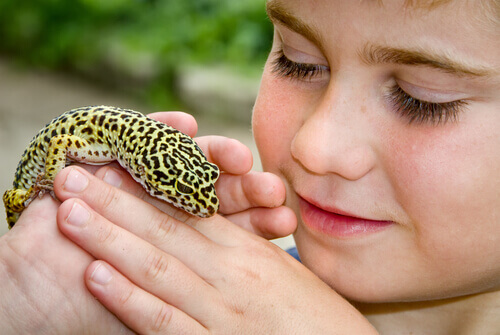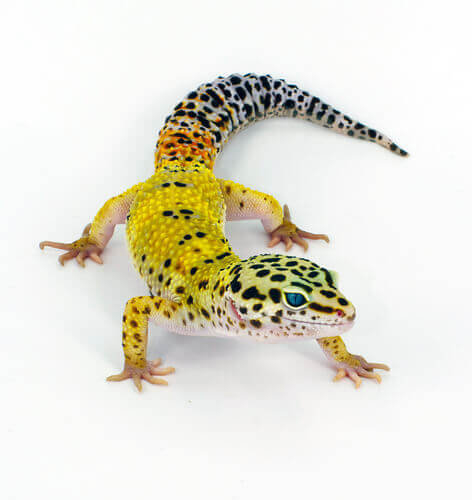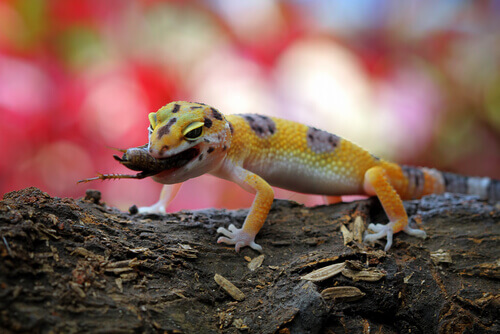The Common Leopard Gecko Is the Ideal Pet

When you think about the perfect small-sized pet that’s easy to take care of, you probably imagine some sort of mammal. Hamsters, gerbils, guinea pigs, and rabbits are a common first choice among pet seekers. However, there are other more exotic options that are just as valid. With that in mind, we want to tell you why the common leopard gecko is the ideal pet.
Introducing this small reptile
The leopard gecko (Eublepharis macularius) is a gecko species that belongs to the Eublepharidae family. Below are some of its characteristics:
- It’s original to semi-arid regions and lives all over the Middle East.
- The size of common leopard geckos varies between 6 and 12 inches long. Their characteristic tails serve as fat reserves, and they can release them in dangerous situations.
- Their typical coloration is yellow with brown spots. However, there are different morphotypes that result from living in captivity.
- In nature, these animals tend to live in colonies, but they adapt just fine to a solitary life. The males of this species are extremely territorial.
- Leopard geckos are extremely docile and it’s very uncommon to see them exhibit any aggressive behavior.
- These animals are insectivores and feed on crickets, cockroaches, and larvae, among other insects. They won’t eat any sort of plant or vegetable.
Sounds like a nice, interesting animal, doesn’t it? Well, there’s even more good news! You can find these reptiles at almost any exotic pet store, and they make for the ideal pet for adults and children alike. So, if you’re interested in bringing a leopard gecko into your home, we’ll tell you what you need to know.

What do you need in order to have a leopard gecko as a pet?
Despite being very easy to take care of, having a leopard gecko as a pet required considerable preparation beforehand.
Terrarium
Depending on how much you want to spend, the terrarium can be the cheapest or the most sophisticated. Let’s be honest, your pet won’t care if its cage is plastic or glass. What matters is size and ventilation.
The appropriate measurements are 27 inches long by 16 inches wide for 2 lizards. It’s important never to put two male leopard geckos together since they can seriously hurt each other. Also, make sure your terrarium has a proper ventilation system. In other words, a plastic box won’t suffice.
Unless you’re an expert and have prior experience, it’s best to purchase a prefabricated terrarium that’s specific for reptiles.
As for bedding, geckos aren’t very picky. So, there’s just one rule you need to follow: the bedding needs to consist of organic matter. These animals hunt their prey using their jaws, and it’s common for them to swallow some bedding when they do. Therefore, sand and rocks are a definite no, as geckos are unable to digest them. In fact, swallowing sand or rocks could lead to death.
- For bedding, you can use anything from toilet paper to corn kernels, coco fiber, or rabbit turf.
It’s also important to include elements that are similar to your pet’s natural environment. For example, hollow trunks and plastic or live plants will help your gecko feel like it’s in its natural habitat.
Humidity and temperature
Since leopard geckos are cold-blooded and come from a semi-arid environment, temperature plays an essential role in their survival.
There needs to be a temperature gradient in the terrarium–ideally around 82.4 degrees. You can achieve this by placing a reptile heating pad on one half of the terrarium. This needs to be stuck on the outside of the structure, underneath, in order to prevent burns. Then, your pet will be able to decide whether it wants to stay in the warm area or the cold area, thus regulating its own body temperature.
As for humidity, placing a plastic container with wet toilet paper inside in the cage will suffice. You should leave the container semi-open so the gecko can crawl inside. These animals require humidity in order to shed their skin correctly, so this is an important point.

Feeding
Gecko leopards are insectivore animals, which is perhaps the biggest “con” when it comes to keeping these pets. You’ll have to have cricket, cockroach, and larvae colonies in your home in order to offer your pet a varied diet. Specialty pet stores will have these insects at a very low price.
- Hunting insects outdoors and feeding them to your pet is never a good idea, as these could carry parasites and kill your pet.
As adults, these reptiles eat every two or three days, and almost every day when young. Adding powdered calcium and vitamin D3 to two of their weekly meals is essential. Again, you can find these vitamin supplements at specialty stores.
The benefits of having a leopard gecko
Despite the initial work that goes into meeting the needs of these wonderful pets, their benefits are uncountable:
- These animals are extremely docile and will allow you to pick them up, handle them, and pet them. You can take them out of their terrariums on a daily basis to give them a bit of company, or to allow them to explore small spaces. Just make sure not to exceed half an hour.
- These animals have behavior that’s impossible to see in many other pets. Processes like skin molting and insect hunting are fascinating, and no domestic mammal will do those things.
- Leopard geckos can live for up to 15 years, unlike many typical domestic micromammals.
- Having leopard geckos as pets teaches little ones to understand the value of biodiversity, and not just focus on traditional furry animals.
In conclusion, as you can see, these beautiful animals are ideal for starting out in the world of herpetology.
While they require previous preparation, these reptiles will provide you with years of accompaniment and knowledge about nature.
